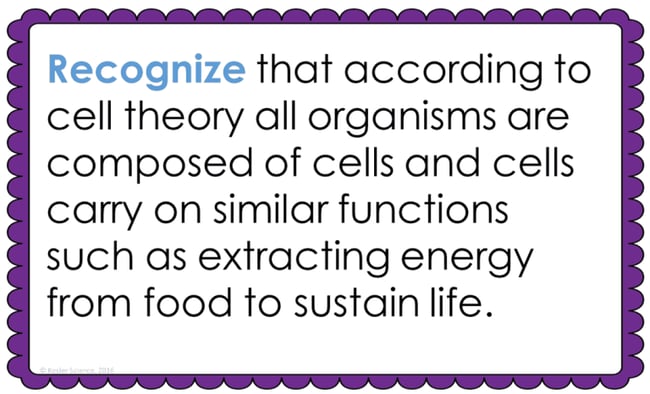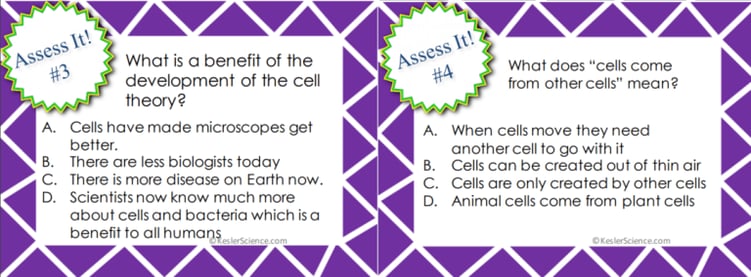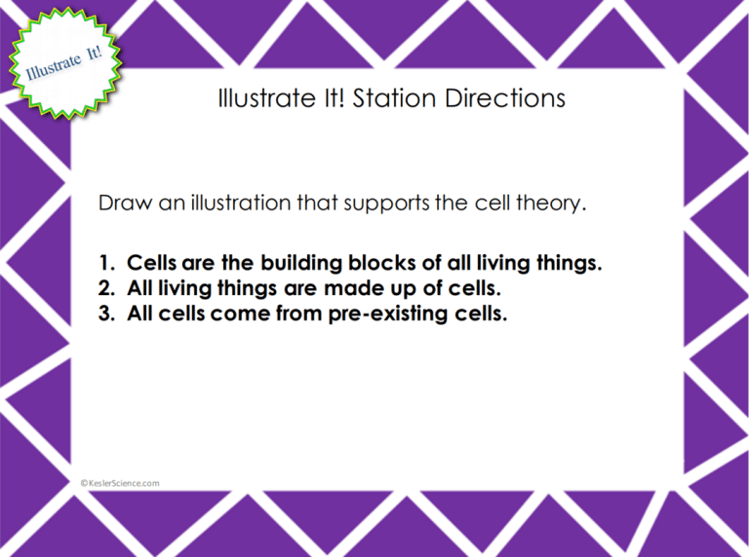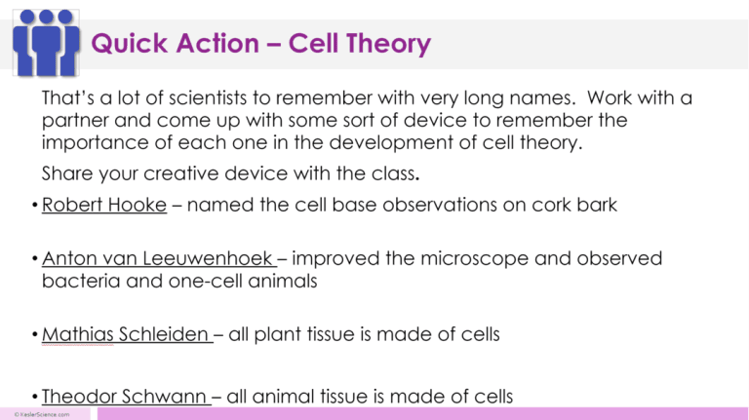
The teacher will help to clear any misconceptions about cell theory. A major misconception is that students believe all cells are the same.
Estimated Class Time for the Engagement: 20-30 minutes
EXPLORATION
This student-centered station lab is set up so students can begin to explore cell theory. Four of the stations are considered input stations where students are learning new information about cell theory and four of the stations are output stations where students will be demonstrating their mastery of the input stations. Each of the stations is differentiated to challenge students using a different learning style. You can read more about how I set up the station labs here.
EXPLORE IT!
Students will be working in pairs to better understand cell theory. Students will be using images to reignite their understanding of biotic and abiotic factors. Since they will discover that all living things are made of cells, students will categorize the cards as either belonging to something that is living and something that is not living. Students will record their observations on their lab sheet.
WATCH IT!
At this station, students will be watching a short video explaining the wacky history of the cell theory. Students will then answer some questions relating to the video and record their answers on their lab station sheet. For example: How were bacteria first discovered? How did Robert Hooke come up with the term 'cell'? How did Rudolf Virchow contribute to the cell theory?
RESEARCH IT!
The research station will allow students to explore the timeline of the creation of the cell theory. Students will see what years contributions were made toward cell theory and will also learn about the scientists that helped. Students will be instructed to complete a few tasks and record answers on their lab sheets.
READ IT!
This station will provide students with a one page reading about cell theory. Students will read information about the discovery of cells, the creation of the microscope, and the scientists that helped to create the cell theory. There are 4 follow-up questions that the students will answer to show reading comprehension of the subject.
ASSESS IT!
The assess it station is where students will go to prove mastery over the concepts they learned in the lab. The questions are setup in a standardized format with multiple choice answers. Some questions will ask students: Which is not a part of the cell theory? What was Robert Hooke's contribution to cells? What is a benefit of the cell theory? What does "cells come from other cells" mean?

WRITE IT!
Students who can answer open-ended questions about the lab truly understand the concepts that are being taught. At this station, the students will be answering three task cards like: List the 3 parts of the cell theory. Why do you believe so many scientists were involved in the development of cell theory? What impact has the cell theory had on the modern day world in which we live?
ILLUSTRATE IT!
Your visual students will love this station. Students will draw an illustration that supports the cell theory. Students will illustrate cell are the building blocks of life, all living things are made of cells, and cells come from other cells.

ORGANIZE IT!
The organize it station allows your students to match the contribution to cell theory with the correct year. Once students have completed their organization, the teacher will come and check their understanding.
Estimated Class Time for the Exploration: 1-2, 45 minute class periods
EXPLANATION
The explanation activities will become much more engaging for the class once they have completed the exploration station lab. During the explanation piece, the teacher will be clearing up any misconceptions about cell theory with an interactive PowerPoint, anchor charts, and interactive notebook activities.
The cell theory lesson includes a PowerPoint with activities scattered throughout to keep the students engaged.
The students will also be interacting with their journals using INB templates for cell theory. Each INB activity is designed to help students compartmentalize information for a greater understanding of the concept. The cell theory INB templates allow students to focus their notes on understanding the cell theory.
Estimated Class Time for the Exploration: 2-3, 45 minute class periods
ELABORATION
The elaboration section of the 5E method of instruction is intended to give students choice on how they can prove mastery of the concept. When students are given choice the ‘buy-in’ is much greater than when the teacher tells them the project they will have to create. The elaboration project will allow students to create a presentation to teach about cell theory.
Estimated Class Time for the Elaboration: 2-3, 45 minute class periods (can also be used as an at-home project)
EVALUATION
The final piece of the 5E model is to evaluate student comprehension. Included in every 5E lesson is a homework assignment, assessment, and modified assessment. Research has shown that homework needs to be meaningful and applicable to real-world activities in order to be effective. When possible, I like to give open-ended assessments to truly gauge the student’s comprehension.
Estimated Class Time for the Elaboration: 1, 45 minute class period
DOWNLOAD THE FULL LESSON NOW
The full lesson is available for download from the Kesler Science Store. Save yourself a ton of time and grab it now.





